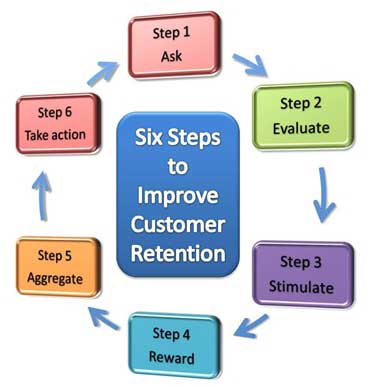Customer retention is ultimately driven by value. Even the best segmentation, targeting, positioning, creative messaging, or promotion with flawless execution will fall flat in the absence of value.
Therefore, in developing a plan to maintain and upgrade a customer base, it is necessary to build on a solid foundation. Only then will the plan lead to greater customer retention and overall organizational success.
To succeed, customer retention must be a top-down, companywide initiative. Truly committing to customer retention is hard work because it affects virtually every aspect of your organization, but the payback in sustainable growth and profitability makes the effort worthwhile.
The path to customer retention involves six key steps.

1. Ask
Ask your customers what they want and what they like and dislike. Include customer surveys on your website, at the point of sale, and in package inserts. You'll likely get "extreme" feedback from customers who love you or hate you. Customers who are mildly satisfied are not as motivated to speak their minds.
But ask only if you're prepared to deal with the responses. Turning a deaf ear to a problem is the kiss of death.
Please remember that customers expect you to take action when they complain, especially if you initiated the dialogue. Use feedback from your surveys to make improvements to your product or service. Customers love it when you listen to them!
2. Evaluate
Evaluate your customer data to find out who your best customers are. That may sound obvious, but the devil is in the details. There may be trends that you've overlooked.
And keep an eye on profitability, not just transactions. In the credit-card industry, for example, deep spenders who pay off their balance each month usually are not as profitable as moderate spenders who carry a balance.
When you know who your best customers are, you can tailor your marketing programs to keep those customers and encourage them to spend more with you.
3. Stimulate
If you have sold your customers a service and they're not using it, get them to activate (e.g., online bill pay, long-distance service, and credit and debit cards).
At the start of a new relationship, there's that warm and fuzzy feeling when new customers sign on. You got them to say yes. Four months later, you're wondering why those customers don't love you. Is it something you did?
No. It's something you didn't do: You sold to them and moved on. You assumed that they would fend for themselves and figure out all the great things about doing business with you.
The first few days and weeks of a new business relationship are critical. Shower them with your kindness. Send direct mail and email reminders. Thank them for their business. Do everything you can to make the "honeymoon" phase of your relationship special.
In the long run, if they're not using your product or service, they're likely to bail when a better deal comes along.
4. Reward
Reward your customers with meaningful perks for doing business with you. It seems like everyone has a loyalty program these days. Customers are getting weary of "me too" programs that don't offer substantial value.
Instead of always giving customers what they expect, give them the unexpected. For example, a midsize accounting firm rewarded some of its best customers with a box of Haigh's chocolates for their business. It was an unexpected, tasty little perk that came out of the blue.
Results? Those customers had above-average retention rates the following year. Sometimes the little things can mean a lot.
5. Aggregate
Try to get all the customer's eggs in your basket. In other words, cross-sell other products and services. Doing so is much easier when you already have a relationship with the customer. Offer customers one-stop shopping, consolidated billing, free postage, and other benefits for giving you more of their business.
Everyone's busy, and consumers are looking for service providers that can make their lives easier. It's what they want, so why not give it to them?
6. Take action
A great product and great customer service are the foundation for customer retention. And positive word-of-mouth is by far the best marketing tool in your arsenal. But you can't control when that happens, so you need a marketing plan to keep the customers you want.
Don't just hope your customers love you—be proactive. Put your plan in writing, and make it stick. Follow through and take action. Use direct mail, email, newsletters, and other marketing tools to make your best customers feel special.
* * *
Treat your best customers with respect, and they'll reward you with loyalty beyond your wildest dreams. Send them targeted messages. Give them special incentives. Keep in mind that it's easier to cultivate your current customer relationships—not to mention less expensive—than it is to begin new ones.
The role of customer retention in the overall organizational strategy is one of protecting and managing the primary source of resources. It is also one of defending and enhancing market position, and of optimizing resources and opportunity.
That is why although seemingly a purely tactical approach, customer retention also belongs in the realm of strategic market planning and is a required strength of any successful organization.
It costs about five times as much to acquire a new customer as it does to keep a current customer. That's why it pays to pay attention to your best customers. In the end, they'll buy more, stick with you longer, and tell their friends how great it is doing business with your company. Isn't that what we all want?



